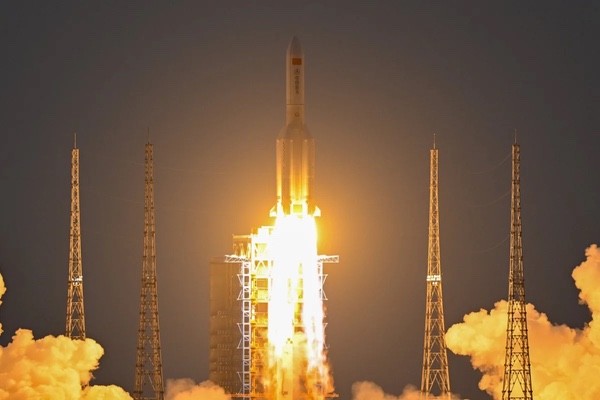Developing and testing China’s Guowang constellationby Greg Gillinger
|
| Western media commonly refers to Guowang as China’s state-sponsored version of SpaceX’s Starlink internet service constellation. However, China’s statements noting several other mission areas and their planned deployment of nearly 13,000 satellites hints at a much broader effort. |
Additional Chinese news sources note that “The ‘GuoWang’ satellite program can carry a variety of payloads, including broadband communication payloads, laser communication payloads, synthetic aperture radar payloads, optical remote sensing payloads, and others, to meet the needs of different users and scenarios. It offers comprehensive technical support across numerous fields such as maritime and aviation operations, information security, navigation and positioning, and meteorological research, while also enabling expansion into the global satellite internet access market.”
This article examines China’s on-orbit test and development of Guowang. From July to December 2023 China launched nine satellites into the higher orbit of 1,111 kilometers. China added another test satellite in November 2024 to bring the number to ten. Finally, in April 2025 China launched its first test satellites to the “low” orbit of 450 kilometers (see table and graphic below).
We lack any technical details or capability descriptions for the Guowang satellites, however there was a Taiwanese media report that noted Guowang integration testing with Chinese Coast Guard surface vessels operating near (or in) Taiwanese territorial waters on February 27, 2024. Taiwanese media reported that the Chinese Coast Guard vessels were involved with some sort of testing involving the Guowang constellation and China’s DF-21D & DF-26B missiles. The DF-21D is known as a “carrier killer” designed to target US aircraft carriers in the Western Pacific and South China Sea while the DF-26B is known as the “Guam Killer” and is China’s first conventionally-armed ballistic missile capable of striking Guam.
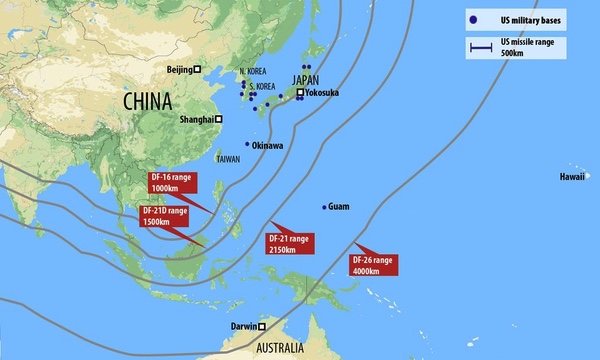 |
Western media commonly refers to Guowang as China’s state-sponsored version of SpaceX’s Starlink internet service constellation. However, China’s statements noting several other mission areas and their planned deployment of nearly 13,000 satellites hints at a much broader effort including imagery, radio frequency (RF) detection, PNT and communication services. Integration of these capabilities with Chinese Air, Land & Sea forces will threaten US and allied operations in the Western Pacific, the South China Sea and beyond.
 Table 1: List of 6 Launches & 14 Guowang Test Satellites and Their Orbital Parameters on 25 May 2025 (celestrak.org) |
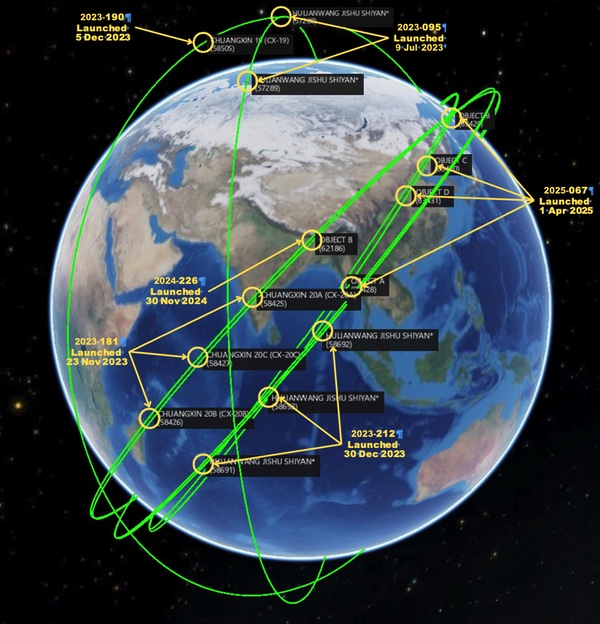 Visualization of 14 Satellites in Guowang Test Constellation (spaceaware.io) |
Initial Guowang test deployment July-December 2023
Based on publicly available data, China began on-orbit testing of its Guowang constellation in 2023. From July to December of that year China conducted four launches with a total of nine “internet technology test” satellites (see table/orbit visualization below for details.) For three of the four launches China publicly stated an incorrect number of satellites. As is often the case with Chinese satellites, the naming convention is also inconsistent. In Western catalogs, six of the satellites are named “Hulianwang Jishu Shiyan,” while the three satellites launched on November 23 are listed as “Chuangxin-20A/B/C.”
The orbital parameters for the nine test satellites are similar to those observed with the first three operational Guowang groups; all are inclined at 50 or 86.5 degrees and have slightly higher average altitude than the test satellites: 1,170 vs 1,111 kilometers respectively.
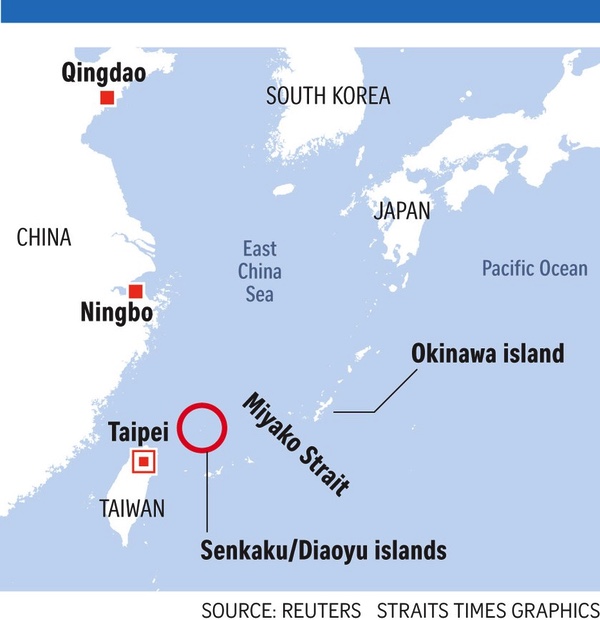 |
Possible integration testing on February 27, 2024
In April 2024, Taiwanese media reported:
On the afternoon of 27 February (2024), three Chinese coast guard ships No. 2303, 2304 and 2305 raided the waters adjacent to (Taiwan’s) eastern 24 km (territorial waters) at a high speed of close to 20 km/hr… According to people familiar with the matter...the Chinese coast guard ships sailed at high speed in a ‘full silence’ mode, and after the analysis of electronic signals detected by friendly forces, it was judged that it should be helping the PLA test China's version of Starlink's ‘State Grid’ (Guowang) to provide information on future precision strikes by the Rocket Force.
According to a person familiar with the matter, the three (Chinese) coast guard ships are testing the Dongfeng-21D and Dongfeng-26B missiles of the Chinese State Grid (Guowang) and providing information to the Chinese Rocket Force to achieve precision strikes. It was not until the southernmost point of the Miyako Strait that the three coast guard ships were detected by friendly forces, and it cannot be ruled out that they were linked to low-orbit satellites launched by China.
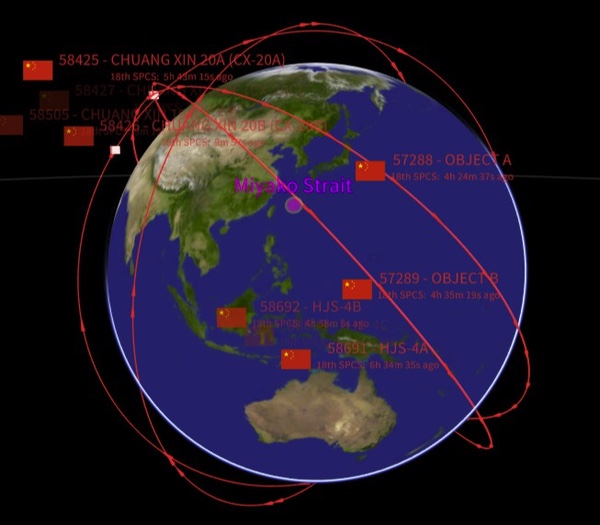 27 Feb 2024: Visualization of Guowang Test Satellites & Miyako Strait (saberastro.com) |
 Table 2: List of nine Guowang Test Satellites and their orbital parameters on 27 Feb 2024 (celestrak.org & saberastro.com) |
Coverage analysis
While we have no technical information regarding the capabilities of Guowang constellation, based on the orbital information available on February 27, 2024, it appears China would have potential Guowang coverage of the Miyako Strait for about 8 hours and 26 minutes on that day (TST timezone). There were several instances where the Guowang satellites provided about 30–60 minutes of consecutive coverage. (see graph below).
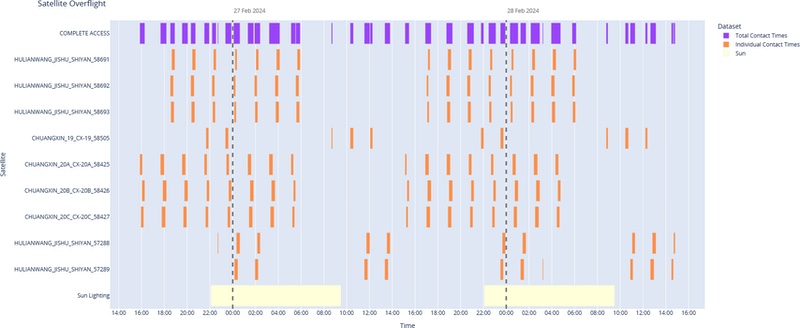 Estimated Coverage of 9 Guowang Test Satellites 26 Feb 2024 1400 - 28 Feb 2024 1600UTC (Taiwan is UTC +8) Each | | = 120min (LSAS Tech) |
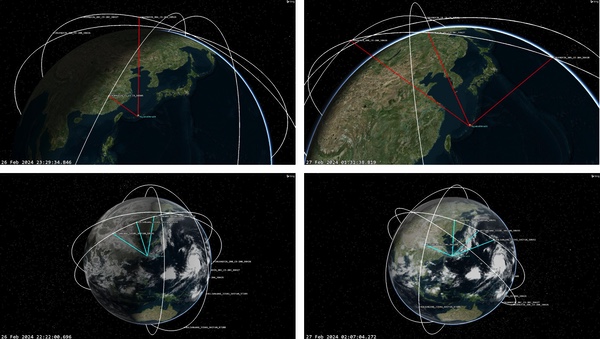 Sporadic Multi-Satellite Coverage over Miyako Strait on 27 Feb 2024 (Times in UTC) (LSAS Tech) |
Concluding Thoughts on 27 Feb 2024 Test:
While we do not know the specific support the Guowang test satellites may have provided the Chinese Coast Guard vessels during this exercise/demonstration/operation, we do know there were nine satellites on orbit and China could have used them in some capacity and in a way which was difficult for the Taiwanese to track. With these test satellites Guowang could provide sporadic coverage to the Miyako Strait. Coverage limitations would constrain testing to roughly 30–60 consecutive minutes at specific times of the day. However, testing would still be possible (see the example of US military testing of Starlink in 2020 when Starlink had about 10% of its current number of satellites on orbit). The 10-month gap between the test near Taiwan and the first operational launch may have provided China with time to incorporate lessons learned into the operational satellites or just confirmed the performance of existing technologies and weapon system compatibility.
Follow-on developments
As noted previously, the four test satellites launched in December 2023 had yet to reach their operational orbits in February 2024. The satellite 58505 (this was the one launched on the Jielong-3 on December 5, 2023, from the Yellow Sea) increased its average altitude about 189 kilometers from May 6 to June 25, 2024. The maneuvers placed 58505 at the same semi-major axis (SMA) as satellites 57288 and 57289 at 1,111 kilometers. The three satellites are all inclined 86.5 degrees with 58505 having a right ascension of the ascending node (RAAN) offset 32 degrees west of 57288/57289. China timed 58505’s maneuvers to place the satellite at a nearly equal distance from 57288 and 57289. (see graphics below). Satellites 58691/92/93 (launched December 30, 2023) increased their average altitudes about 165 kilometers from March to April 2024 and have maintained their orbits at 1,104 kilometers.
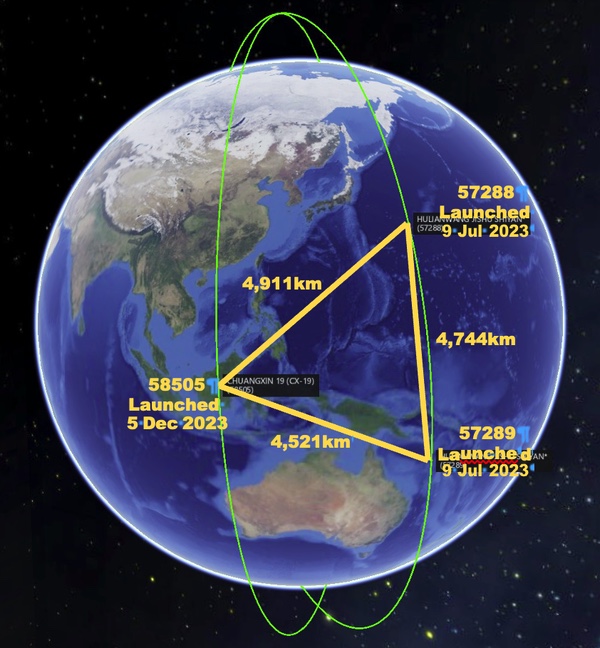 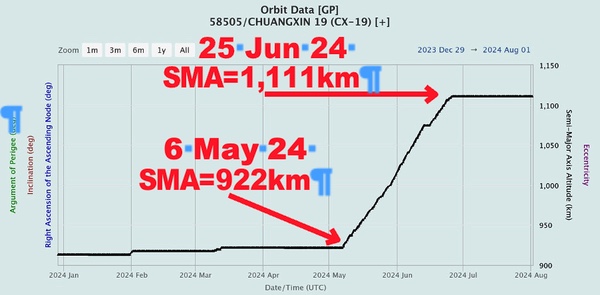 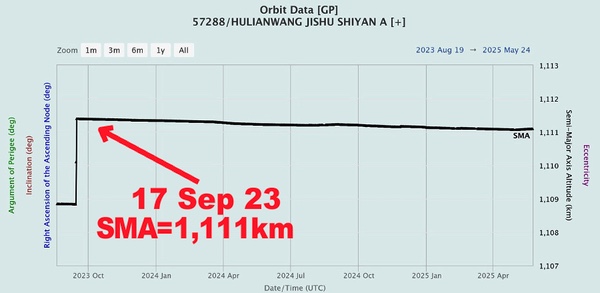 May-Jun 2024: China Increased Average Altitude (SMA) of 58505 to Match 57288/89 at 1,111km The Maneuvers Were Timed to Place the Satellites Nearly Equal Distance from One Another (celestrak.org, spaceaware.io & saberastro.com) |
China launched another Guowang test satellite, 62186, on its inaugural Long March-12 launch on November 30, 2024. There were two satellites onboard; the other, 62185, appears to be another experimental satellite, as the naming convention and orbit suggest it is not associated with Guowang. China referred to 62186 as a “Satellite Internet Technology Test Satellite” which is identical to other Guowang missions. More importantly, China launched 62186 into a nearly co-planar orbit with the three satellites it had launched almost exactly one year prior, on November 23, 2023 (58425, 58426, and 58427). The satellite increased its SMA for its first two months on orbit, finally stabilizing at 1,104 kilometers, just 7 kilometers less than 58425/26/27. There is a slight RAAN offset of less than 1 degree. All four satellites are in 50-degree inclined orbits.
 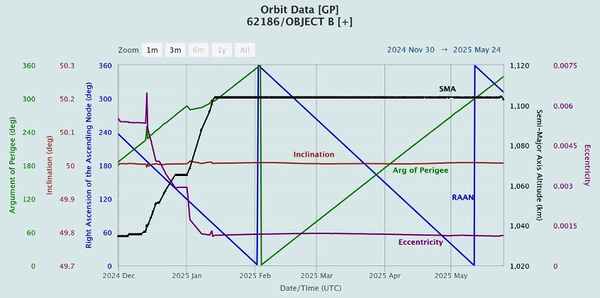 Launched 53 Weeks Apart 62186 is Nearly Co-Planar with 58425/26/27. 62186 is at a slightly lower SMA and will slowly lap the other three satellites. (spaceaware.io & celestrak.org) |
Finally, on April 1, 2025, China launched four satellites (63428–63431) into a much lower orbit (450 kilometers) and a new inclination (55 degrees.) China used a Long March-2D from Jiuquan with the first use of a 3.8-meter composite payload fairing. I suspect these are test satellites for the lower altitude Guowang variant. According to Chinese social media, two of the satellites were manufactured by Galaxy Space and the other two were from the Chang Guang Satellite Technology Co. Three of the four satellites have since increased their average altitude since launch to about 452 kilometers. The fourth satellite (63428) may have suffered an anomaly. The satellite has yet to maneuver and its SMA has decayed to 428 kilometers; it is also no longer co-planar with the other three due to a west RAAN offset of 1.3 degrees.
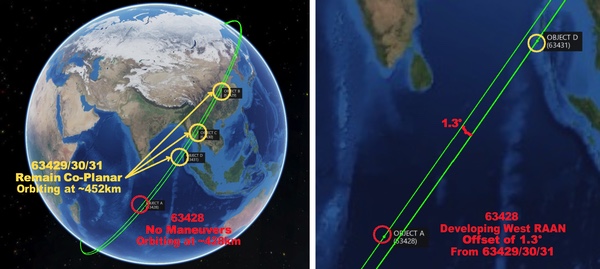 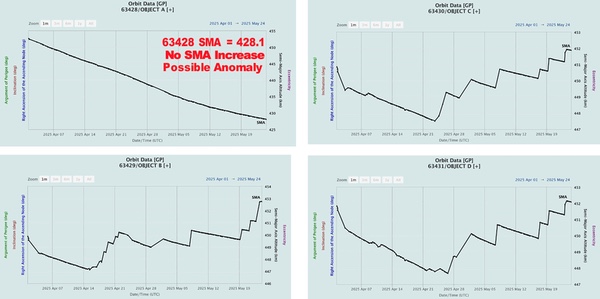 3 of 4 Low Altitude Guowang Satellites have increased SMA to ~452km & Remain Co- Planar. “Obj A” has yet to maneuver and may have suffered an anomaly. (spaceaware.io & celestrak.org) |
Comparison with Western constellations
In terms of average altitude and inclination, China has placed their test and operational satellites into orbits like those used by the OneWeb constellation. OneWeb satellites orbit about 100 kilometers higher than the Guowang test satellites (1,200 vs. 1,100 kilometers average altitude respectively), but are at nearly the same average altitude as the 29 operational Guowang satellites, the first of which are orbiting at 1,170 kilometers (see table below). All of OneWeb’s satellites are in orbits inclined at 87.5 degrees. China is using two inclinations, 50.0 and 86.5 degrees.
| Western media tends to compare Guowang with Starlink, while in reality the Guowang constellation is likely to be capable of providing remote sensing and PNT services in addition to high-throughput, low-latency connectivity |
Operating at 1,200 kilometers, OneWeb is able to provide global coverage with its 654-satellite constellation and supporting ground sites. China’s Guowang constellation plans to have more than ten time this number (6,912) at about the same average altitude. The volume of satellites will likely enable intersatellite connectivity, decreasing ground station support requirements (the current OneWeb constellation does not have this capability) and could indicate the use of other missions such as remote sensing and PNT. In terms of remote sensing, 1,100–1,200 kilometersis higher than is typical high resolution imagery satellites, but is near the same altitude as China’s Yaogan-31 radio frequency detection/geolocation satellites, which are orbiting at just under 1,100 kilometers.
China also plans to operate more than 6,000 satellites at average altitudes of 400–500 kilometers. By comparison, Starlink satellites operate at about 550 kilometers. Starlink has previously announced its final constellation would be about 12,000 satellites, but that number has been revised several times. As of late March 2025 there were 7,135 Starlink satellites in orbit, of which 7,105 are working. Announced plans for Guowang call for 6,080 low-orbit satellites that, by themselves, may not be sufficient for global communication coverage but could be more than capable of providing ultra-low latency and high data rates in the Western Pacific and South China Sea regions. Operating at this altitude will also support high-resolution imagery and other remote sensing collection.
As stated previously, China has not publicly released any detailed information regarding the capabilities of the Guowang satellites. However, a recent Andrew Jones report noted, ”The China Academy of Space Technology (CAST)… stated in December [2024] it had developed large and small satellite platforms for Guowang, without disclosing functional differences.” China has conducted three operational launches to date, two of which used the massive LM-5B (LEO capacity of about 25,000 kilograms) to launch 10 satellites each, and the third using the new LM-8A (7,000 kilogram LEO capacity) to launch nine satellites. It is a solid assumption to assume the LM-5B launches were used for the larger variant while the LM-8A was used for the smaller variant. Mass is one of many factors in deciding a launch platform, but China’s use of the LM-5B hints of satellites which are decidedly more massive (up to 2,500 kilomgrams) than those used for OneWeb (150 kilograms) or any of the Starlink satellite variants (260-–1,250 kilograms).
 Table 3: Guowang Launch Vehicles, Max Mass Lift to LEO & Average Mass/Satellite (spaceaware.io & celestrak.org) |
Conclusion
While China has released some information regarding the Guowang constellation architecture, little information is known regarding the capabilities of its Guowang satellites. Western media tends to compare Guowang with Starlink, while in reality the Guowang constellation is likely to be capable of providing remote sensing and PNT services in addition to high-throughput, low-latency connectivity. High-resolution commercial non-Earth imagery and video of these satellites would reveal additional capabilities.
Tracking the operational status of such a large volume of satellites will present a tremendous challenge to US and coalition forces. While difficult, providing this operational intelligence to friendly air/land/sea forces operating in the Western Pacific and South China Sea, is imperative. Early Guowang testing involved supporting long-range precision strike weapon systems and it is logical that China is building Guowang to improve its find, fix, track, target, engage, and assess kill-web. Lowering or eliminating classification restrictions through the use of commercial or other publicly available sources will greatly increase the number of countries and personnel able to contribute to the operational intelligence analysis effort.
Note: we are now moderating comments. There will be a delay in posting comments and no guarantee that all submitted comments will be posted.
